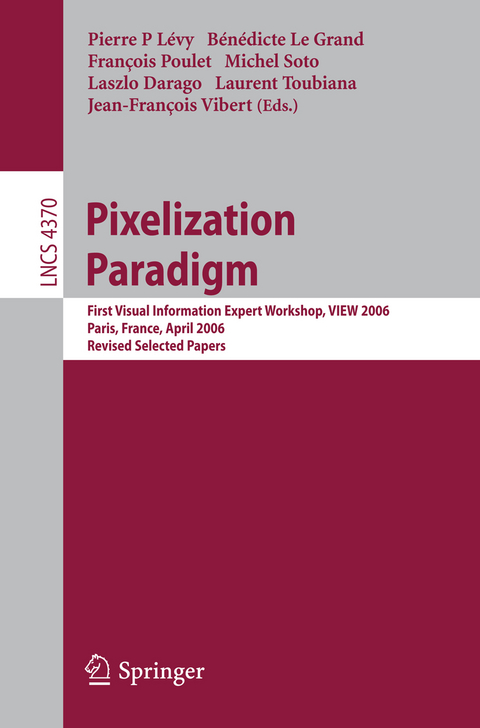
Pixelization Paradigm
Springer Berlin (Verlag)
9783540710264 (ISBN)
Pixelization Theory.- Pixelization Paradigm: Outline of a Formal Approach.- Scalable Pixel Based Visual Data Exploration.- High Dimensional Visual Data Classification.- Using Biclustering for Automatic Attribute Selection to Enhance Global Visualization.- Pixelisation-Based Statistical Visualisation for Categorical Datasets with Spreadsheet Software.- Dynamic Display of Turnaround Time Via Interactive 2D Images.- Pixelizing Data Cubes: A Block-Based Approach.- Leveraging Layout with Dimensional Stacking and Pixelization to Facilitate Feature Discovery and Directed Queries.- Online Data Visualization of Multidimensional Databases Using the Hilbert Space-Filling Curve.- Pixel-Based Visualization and Density-Based Tabular Model.- Pixelization Applications.- A Geometrical Approach to Multiresolution Management in the Fusion of Digital Images.- Analysis and Visualization of Images Overlapping: Automated Versus Expert Anatomical Mapping in Deep Brain Stimulation Targeting.- A Computational Method for Viewing Molecular Interactions in Docking.- A Graphical Tool for Monitoring the Usage of Modules in Course Management Systems.- Visu and Xtms: Point Process Visualisation and Analysis Tools.- Visualizing Time-Course and Efficacy of In-Vivo Measurements of Uterine EMG Signals in Sheep.- From Endoscopic Imaging and Knowledge to Semantic Formal Images.- Multiscale Scatterplot Matrix for Visual and Interactive Exploration of Metabonomic Data.- ICD-View: A Technique and Tool to Make the Morbidity Transparent.- Pixelization and Cognition.- Time Frequency Representation for Complex Analysis of the Multidimensionality Problem of Cognitive Task.- Instant Pattern Filtering and Discrimination in a Multilayer Network with Gaussian Distribution of the Connections.- AC3 - AutomaticCartography of Cultural Contents.- Evaluation of the Mavigator.
| Erscheint lt. Verlag | 9.2.2007 |
|---|---|
| Reihe/Serie | Image Processing, Computer Vision, Pattern Recognition, and Graphics | Lecture Notes in Computer Science |
| Zusatzinfo | XV, 288 p. With online files/update. |
| Verlagsort | Berlin |
| Sprache | englisch |
| Maße | 155 x 235 mm |
| Gewicht | 511 g |
| Themenwelt | Informatik ► Grafik / Design ► Digitale Bildverarbeitung |
| Schlagworte | 2D view • 3D vision • Algorithm analysis and problem complexity • Bioinformatics • classification • Clustering • Cognition • Computer Graphics • Databases • Data Mining • feature extraction • filtering • Hardcover, Softcover / Informatik, EDV/Informatik • HC/Informatik, EDV/Informatik • Image Retrieval • Layout • mapping • medical data modeling • Medical Images • multimodal images • multi-resolution • Pattern Analysis • pattern recognition • pixel-based visualization • registration • Segmentation • Transformation • virtual schemas • visual data exploration • Visualization • Web-Based Cooperation |
| ISBN-13 | 9783540710264 / 9783540710264 |
| Zustand | Neuware |
| Informationen gemäß Produktsicherheitsverordnung (GPSR) | |
| Haben Sie eine Frage zum Produkt? |
aus dem Bereich


